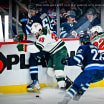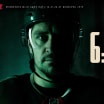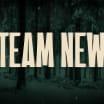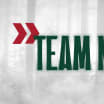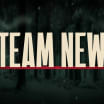With a little more than a minute left in its home opener against the Winnipeg Jets, the Wild trailed by a goal, had its goaltender on the bench for the extra attacker and was pushing hard to tie the game.
But as the Wild pressured for the equalizer, one turnover sent the Jets the other way with the puck and a yawning cage in front of them.
Kyle Connor skated through the neutral zone and dished to Andrew Copp, who left the puck for Mark Scheifele, who entered the offensive zone and whipped the puck into the open cage, giving the Jets a 6-4 lead.
Game. Set. Match.
Wild's video coaches serve as eyes, ears behind the scenes
Duo played critical role in Minnesota's home opening win over the Winnipeg Jets after successful challenge

"Nobody on our bench thought it was offside," admitted Wild head coach Dean Evason.
Xcel Energy Center's raucous sell out crowd began filing towards the exits as the Wild bench slumped in disappointment.
It was especially disappointing for the coaching staff, which desperately wanted to start the home schedule off on the right note. The building was full and the Wild had started the season with a pair of wins on the West Coast. A 3-0 start to the season would have been quite the feather in the cap.
But it wasn't meant to be.
Until suddenly, there was a glimmer of hope.
While almost every one in the building assumed the game was all but over, Wild video coach T.J. Jindra was tapping away on the keyboard on his Hawkeye Replay Software in the coach's office, about 30 feet below Section 118 at Xcel Energy Center, adjacent to the team's dressing room.
Back and forth, frantically switching camera angles from the TV view, to one side of the blue line, then to the other, reverse angle ... any view of the play he could set his eyes on, using the mouse to zoom in on certain angles.
Back and forth, analyzing a half second of video like it's the Zapruder film. Sitting next to him marking the game tape on his XOS Thunder video system was Jonas Plumb, a Wild video coach for more than a decade.
Together, Jindra and Plumb analyze, re-analyze, discuss and prepare to make a final decision. As both the Wild and Jets gathered near center ice to drop the puck and play out the final 74 seconds of regulation, it was Plumb who grabbed the walkie talkie between them, squeezed the button and declared that he and Jindra believe the play is offsides.
On the Wild bench, assistant coach Brett McLean is wearing the ear piece that receives Plumb's transmission. As the two centermen prepare to take the next faceoff, McLean and the Wild bench is frantically trying to gain the attention of referee Chris Rooney.
Thankfully, they do.
When Rooney approaches the bench, Evason tells him that he is challenging the goal on the basis that it was offsides at the Jets' offensive blue line.
McLean estimated it took 10 seconds after the goal is called until he heard the first crackle from the video room that they're taking a look.
"'That might be off, let us take a look,'" McLean remembered the words like they were said yesterday. "But there still wasn't a lot of hope [on the bench]."
About 15 seconds after that, it crackled a second time, confirming their initial belief and inkling to challenge the goal.
"'That's offside, that's offside,'" McLean repeated. "And that's when started getting pretty animated."
The first couple of replays inside Xcel Energy Center show the goal again from the angle fans at home saw on TV, one that doesn't show anything that would appear to wipe away the goal.
That angle, of course, blocks the view of Connor's skates near the right-wing wall.
Once the camera view from the other side of the ice is shown, the buzz of those who still remain in the seating bowl begins to build.
Linesmen Ryan Daisy and Steve Barton look over the play on an iPad near the penalty box, pouring over the screen much like Jindra and Plumb had just done.
After a minute or two of review, the linemen confirm what Wild video coaches did, share their ruling with referee Chris Rooney, who steps to center ice, looks into the camera, opens the microphone located on his right hip and reveals to the fans left in the building and those still watching on television that the goal will not count, waving his arms out and declaring "no goal," to the delight of those that remained.
Suddenly, those slumped shoulders were on the Jets bench, a renewed energy burst through the Wild's players and a mad dash to the seats ensued for thousands of fans who heard the news from the Xcel Energy Center concourse.
It took less than 20 seconds for Minnesota to tie the game and force overtime, where it secured a critical second point on Joel Eriksson Ek's hat trick goal.
WPG@MIN: Eriksson Ek wins it in OT
The win by the Wild marks a three-point swing in the Central Division standings ... a swing that wouldn't have been possible without the work of the team's video coaches.
"I know they probably wouldn't tell you this, but I think sometimes you don't feel a part of this because they're back there," Evason said. "But we make a conscious effort to let everyone know that they are a critical part of our coaching staff too.
"I'm sure it was nice for them too to be a part of making a call that allowed us to have success."
\\\\\\
Plumb got his start as a video coach during the 2004-05 season in the Western Hockey League with the Vancouver Giants organization.
It wasn't a job that was posted online, or even through word-of-mouth, it was something he just sort of stumbled into.
Plumb wasn't with the Giants as a video coach, instead, he was there to work with the marketing department, putting to use his marketing degree.
He'd do a little bit of everything with the Giants, helping out in anyway possible as a sort of internship in order to get his foot in the door. That season, however, the club got a new video system and the coaching staff asked Plumb if he'd like to help out on a part-time basis.
"I thought it was great because I always wanted to work in sports," Plumb said. "I never thought I'd work on this side of sports, I always thought it'd be more on the business side. But that was how I first started."
Plumb broke down all the team's video, built highlight tapes and did a number of odds and ends, helping the Giants win the WHL championship in 2006 and the Memorial Cup in 2007, setting the stage for a move to the Washington Capitals in 2008.
There, Plumb got his first exposure to some familiar faces, working with former Wild head coach Bruce Boudreau, as well as current Wild head coach Dean Evason. Current Wild assistant coach Bob Woods was the head coach for the Caps' AHL affiliate in Hershey.
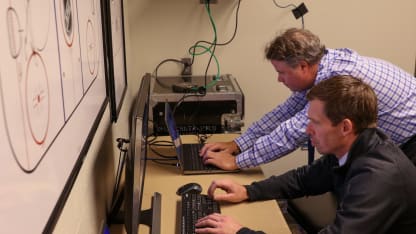
After one season in Washington, Plumb returned to Vancouver and did some work for Team Canada and was with Team Sweden at the 2010 Winter Olympics before being hired by the Wild. He worked for former Wild head coaches Mike Yeo, John Torchetti and Boudreau before being reunited with Evason on a full-time basis before last season.
"You have to trust," Evason said. "We talk to our team about trusting each other, we need to trust each other as a coaching staff, and me as head coach, I need to trust that the video coach gets the job done without us harping on them every single second."
Perhaps Plumb's most tangible duty is to mark each game in real time so that video clips can be shown to players on iPads on the bench and to review with the coaching staff during intermission meetings.
All the information can then be properly catalogued and used before practices and during special teams meetings as well.
"For me, my job is to make sure [the on-ice coaches] have everything they need, so all they need to worry about is hockey," Plumb said. "You've gotta be prepared and you've gotta be organized. They have a lot on their minds, so you have to be organized so nothing falls though the cracks."
Plumb said Evason has done a great job of making everyone the coaching staff - behind the bench, on the ice and in the video room - feel like one big group.
"My favorite part about this job are the people I work with every day," Plumb said. "It really is a great bunch of guys."
\\\\\\
Jindra, a Faribault native who played prep hockey at Burnsville and his college hockey at Notre Dame, has his sights set on one day again soon being behind the bench.
A captain his final two seasons with the Fighting Irish, Jindra took a year off from the game but realized quickly how much he missed the game. So he moved into coaching, starting in his hometown at Shattuck St. Mary's, before moving onto the college ranks. He wore several different administrative hats during a one-year stop at his alma mater before joining the coaching staff at the University of Alaska-Anchorage.
After four years with the Seawolves, Jindra spent one year at the University of St. Thomas and another in the USHL with the Madison Capitols before returning to the college ranks at St. Cloud State University, where he served as the Director of Hockey Operations, a job tasked with, among other things, spearheading the video operations.
"I've got a lot of tracksuits," Jindra said with a laugh.
It was SCSU head coach Brett Larson who encouraged Jindra to look around for a video coaching job with an NHL team, something he hadn't even thought about or lusted after.
"The idea was that I'd run in those circles and they'd help get me a college [assistant coaching job]," Jindra said. "But there weren't a lot of openings."
Jindra had always had his sights on being a college coach.
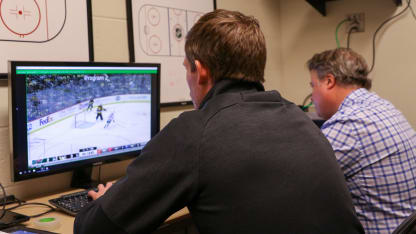
"Honestly, I wanted to get into college athletics. That's why I got into this," Jindra said.
But his hometown Wild was calling, and it was an opportunity Jindra couldn't afford not to explore. He applied for a job as a video scouting coordinator and was chosen by Wild GM Bill Guerin and then-Assistant GM Tom Kurvers for the job.
A year later, he was named video coach. And while Plumb handles the in-game video for players, Jindra assists by providing video to the scouting staff. This season, his second working hand-in-hand with Plumb, Evason has invited Jindra to be on the ice, serving as an additional coach there. He diagrams plays on the white board and is hands on, no different than Evason, Woods, McLean or Hendrickson.
Jindra didn't think he'd ever be an NHL coach, but he's gaining invaluable experience as he continues his ascent up the coaching ladder.
"It's been awesome," Jindra said. "I think that's why you get into coaching, to go on the ice, to work with the players and to help them get better. And that's what I enjoy."
\\\\\\
The play against the Jets was simply a microcosm of what the Wild video coaches do every play, all game long.
Any time a Wild opponent enters the offensive zone, Jindra dials up a series of replays to analyze whether the play was onside or not.
Every offensive zone entry, all game long, no matter how close the play is.
While coaches on the bench thought nothing of the Winnipeg zone entry - it did seem rather mundane at live speed - a big reason why the Wild caught the play was that Jindra is in the habit of literally analyzing every single offensive zone entry, no matter what.
Watching in real time, the puck looked like it entered the zone ahead of Connor's skates. But look back and slow it down, and you'll see Scheifele pull the puck back about a foot, just as he was about to cross the blue line.
That small pull back allowed just enough time for Connor's skates to enter ahead of the puck.
Without it, the game would have been over and the Wild's home season would have started out in disappointing fashion.
"Honestly, we weren't even thinking about it," McLean said. "It didn't even cross my mind that he could be offside. That's all on the video coaches, they caught that."
But the play really was a team effort.
Jindra got the first look at the play, but it's goaltending coach Freddy Chabot serving as the eye in the sky and also on a walkie talkie, that will serve as a second set of eyes in real time. Normally, it's Darby Hendrickson on the bench wearing the ear piece who provides that vantage point (he missed home opener because he was in COVID-19 protocol).
Jindra and Plumb, of course, work in tandem downstairs and analyze any close play at the line.
And in this case, even Wild forward Ryan Hartman played a crucial role. After the apparent goal was scored, Hartman's line was up next off the bench. Referees will often afford teams a few seconds to look at replays, but Hartman did the veteran move of slow-playing his approach to the faceoff dot, allowing for a couple extra looks at the play and providing precious time for the video coaches to get an extra peek or two.
It also allowed for enough time for the video coaches to notify the bench, and for the bench to alert the referees that they were indeed challenging.
Ultimately, issuing any challenge falls on Evason. Plumb and Jindra are the men he leans on, and he's got nothing but faith.
"I have the utmost trust in them," Evason said. "As a staff, we have so much trust in everything they do video wise. We get our pre-scouts done, we get our practice plans done, it's just dialed in.
"Our meetings are so tight - and by tight I mean everything; graphics are put into place, everything is professional - and I think that filters down to our [players]. They see how professional we are and in turn, now they have to be professional. And that is mostly because of what they do behind the scenes."
All photos by Brandon McCauley

